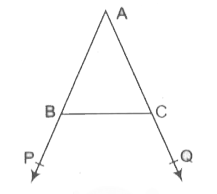In Fig.
 , sides AB and AC of ΔABC are extended to points P and Q respectively. Also ∠PBC<∠QCB. Show that AC>AB.
, sides AB and AC of ΔABC are extended to points P and Q respectively. Also ∠PBC<∠QCB. Show that AC>AB.
Step by step video & image solution for In Fig. , sides AB and AC of DeltaABC are extended to points P and Q respectively. Also anglePBC < angleQCB. Show that AC > AB. by Maths experts to help you in doubts & scoring excellent marks in Class 11 exams.
Updated on:21/07/2023Similar Questions
The inequation that best describes the following graph is _________
View SolutionIn Fig, find the value of x.
ltimg src="https://d10lpgp6xz60nq.cloudfront.net/physics_images/PS_MATH_IX_C12_S01_032_Q01.png" width="80%"gt
View SolutionIn the figure (not to scale) AB = AC and BD = CD. Find ∠ADB
ltimg src="https://d10lpgp6xz60nq.cloudfront.net/physics_images/PS_MATH_IX_C15_E05_003_Q01.png" width="80%"gt
View SolutionAt point P, the value of (dy)/(dx) is : ltimg src="https://d10lpgp6xz60nq.cloudfront.net/physics_images/ALN_PHY_R04_E01_025_Q01.png" width="80%"gt
View SolutionIn the chemical reactions,
ltimg src="https://d10lpgp6xz60nq.cloudfront.net/physics_images/JM_10_CHE_P1_E01_009_S01.png" width="80%"gt
the compounds 'A' and 'B' respectively are
View Solutionआकृति में △ABC की भुजाओ AB और AC को क्रमश: बिन्दुओ P और Q तक बढ़ाया गया है, ∠PBC<∠QCB साथ ही है दर्शाइए की AC>AB है

View SolutionIn the given figure sides AB and AC of △ABC, are extended to point P and Q respectively. Also ∠PBC<∠QCB. Show that AC>AB.

View SolutionIn the given fig. If DE||BC Find EC.
ltimg src="https://d10lpgp6xz60nq.cloudfront.net/physics_images/MATH_241_X_SQP_E01_021_Q01.png" width="80%"gt
View Solution
